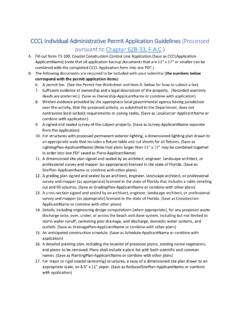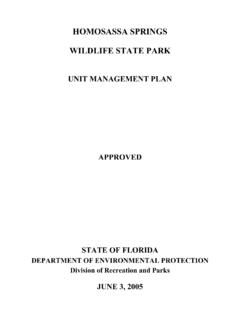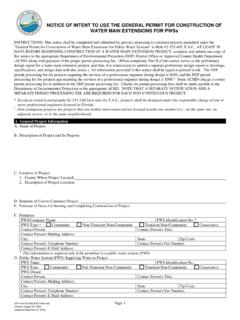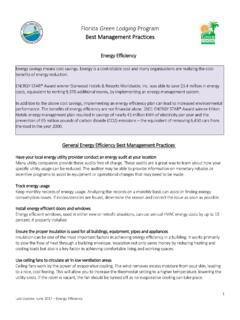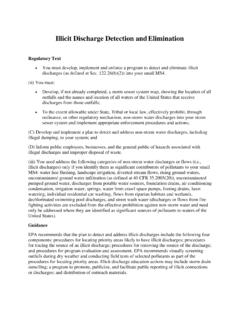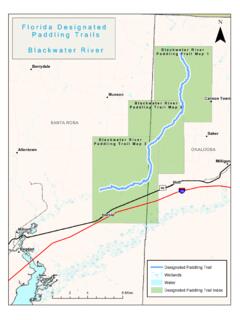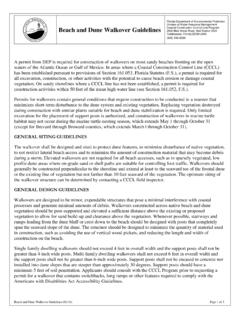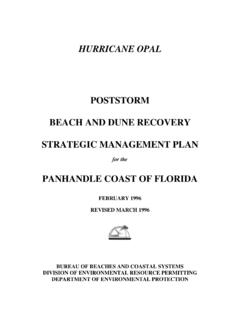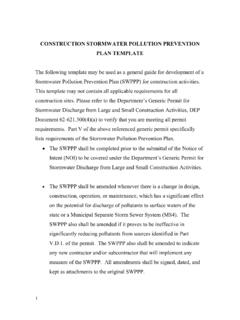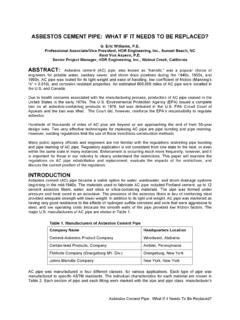Transcription of RECOMMENDED STANDARDS for WASTEWATER FACILITIES
1 RECOMMENDED STANDARDS for WASTEWATER FACILITIES POLICIES FOR THE DESIGN, REVIEW, AND APPROVAL OF PLANS AND SPECIFICATIONS FOR WASTEWATER COLLECTION AND TREATMENT FACILITIES 2004 EDITION A REPORT OF THE WASTEWATER COMMITTEE OF THE GREAT LAKES -- UPPER MISSISSIPPI RIVER BOARD OF STATE AND PROVINCIAL PUBLIC HEALTH AND ENVIRONMENTAL MANAGERS
2 MEMBER STATES AND PROVINCE ILLINOIS new york INDIANA OHIO IOWA ONTARIO MICHIGAN PENNSYLVANIA MINNESOTA WISCONSIN MISSOURI PUBLISHED BY: Health Research, Inc.
3 , Health Education Services Division Box 7126 Albany, 12224 Phone: (518) 439-7286 Visit Our Web site TABLE OF CONTENTS CHAPTER PAGE 10 ENGINEERING REPORTS AND FACILITY PLANS 10. General .. 10-1 11. Engineering Report Or Facility 10-1 20 ENGINEERING PLANS AND SPECIFICATIONS 20. Plans And Support Documents .. 20-1 21. Specifications .. 20-5 22. Revisions To Approved 20-5 30 DESIGN OF SEWERS 31. Approval Of 32. Design Capacity And Design 30-1 33. Details Of Design And Construction .. 30-1 34. 30-7 35. Inverted Siphons .. 30-8 36. Sewers In Relation To Streams.
4 30-9 37. Aerial 30-10 38. Protection Of Water Supplies .. 30-10 40 WASTEWATER PUMPING STATIONS 41 General .. 40-1 42 Design .. 40-1 43 Suction-Lift Pump 40-7 44 Submersible Pump Stations - Special Considerations .. 40-8 45 Screw Pump Stations - Special Considerations .. 40-9 46 Alarm Systems .. 40-9 47 Emergency Operation .. 40-10 48 Instructions And Equipment .. 40-13 49 Force Mains .. 40-13 50 WASTEWATER TREATMENT FACILITIES 51. Plant Location .. 50-1 52. Quality Of Effluent.
5 50-1 53. Design .. 50-1 54. Plant Details .. 50-4 55. Plant Outfalls .. 50-6 56. Essential FACILITIES .. 50-6 57. Safety .. 50-10 58. 50-13 10-3 60 SCREENING, GRIT REMOVAL, AND FLOW EQUALIZATION 61. Screening 60-1 62. 60-5 63 Grit Removal FACILITIES .. 60-6 64. Preaeration .. 60-8 65. Flow Equalization .. 60-8 70 SETTLING 71. General .. 70-1 72. Design Considerations .. 70-1 73. Sludge And Scum Removal .. 70-5 74. Protective And Service FACILITIES .. 70-6 80 SLUDGE PROCESSING, STORAGE, AND DISPOSAL 81.
6 General .. 80-1 82. Process Selection .. 80-1 83. Sludge 80-1 84. Anaerobic Sludge Digestion .. 80-2 85. Aerobic Sludge Digestion .. 80-10 86. High pH Stabilization .. 80-13 87. Sludge Pumps And Piping .. 80-16 88. Sludge 80-17 89. Sludge Storage And Disposal .. 80-21 90 BIOLOGICAL TREATMENT 91. Trickling Filters .. 90-1 92. Activated Sludge .. 90-6 93. WASTEWATER Treatment 90-16 94. Other Biological Systems .. 90-26 100 DISINFECTION 101. General .. 100-1 102. Chlorine 103. 100-6 104. Ultraviolet Radiation Disinfection.
7 100-9 105. Ozone .. 100-10 110 SUPPLEMENTAL TREATMENT PROCESSES 111. Phosphorus Removal By Chemical Treatment .. 110-1 112. High Rate Effluent Filtration .. 110-5 APPENDIX HANDLING AND TREATMENT OF SEPTAGE AT A WASTEWATER TREATMENT A-1 v FOREWORD In 1947, a "Committee on Development of Uniform STANDARDS for Sewage Works" was created by the group now known as the Great Lakes -- Upper Mississippi River Board of State and Provincial Public Health and Environmental Managers. This Committee, composed of a representative from each state, was assigned the responsibility to review existing STANDARDS for sewage works, to investigate the possibility of preparing joint STANDARDS to be adopted by the states represented, and to report its findings to the Board.
8 Based on this initial report, the Board authorized the Committee to prepare sewage works design STANDARDS , which were first published in 1951. They subsequently were revised and published again in 1960, 1968, 1971, 1973, 1978, 1990 and 1997. In 1977, the Province of Ontario was invited, as a Great Lakes participant, to serve on the Committee. These STANDARDS have again been revised and are published herein as the 2004 edition. They are intended for use as a guide in the design and preparation of plans and specifications for WASTEWATER FACILITIES insofar as these STANDARDS are applicable to normal situations for an individual project.
9 The design criteria in these STANDARDS are intended for the more conventional municipal WASTEWATER collection and treatment systems. Innovative approaches to collection and treatment, particularly for the very small municipal systems, are not included. The individual reviewing authority should be contacted for design guidance and criteria where such systems are being considered. Lack of description or criteria for a unit process or equipment does not suggest it should not be used, but only that consideration by the reviewing authority will be on the basis of information submitted with the design. Engineering data that may be required for new process and application evaluation is included in Paragraph of these STANDARDS .
10 These STANDARDS are intended to suggest limiting values for items upon which an evaluation of the plans and specifications will be made by the reviewing authority; and to establish, as far as practicable, uniformity of practice among the several states and province. Statutory requirements, regulations, and guidelines among the states and province are not uniform and use of the STANDARDS must adjust itself to these variations. Users also should be cognizant of locally adopted STANDARDS and applicable federal requirements. The term "shall" is used where practice is sufficiently standardized to permit specific delineation of requirements or where safeguarding of the public health or protection of water quality justifies such definite action.
